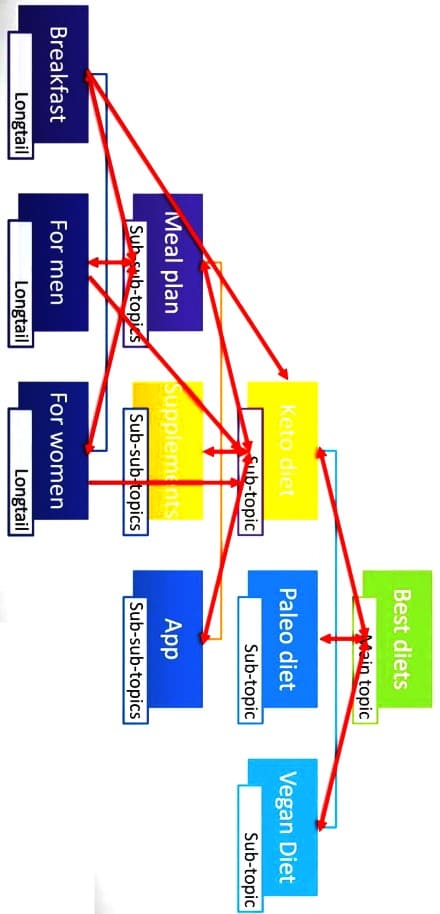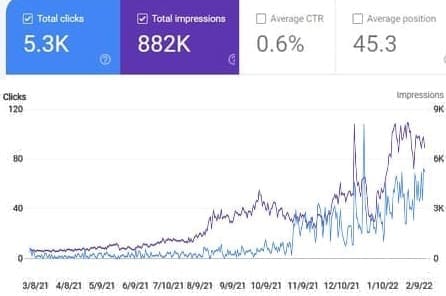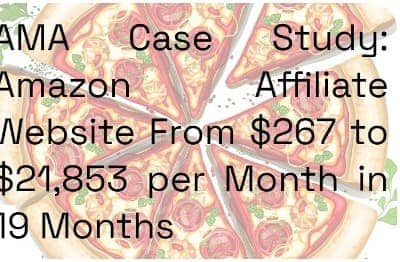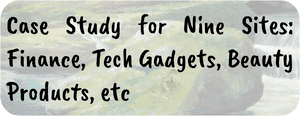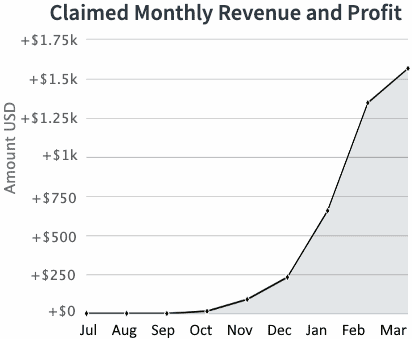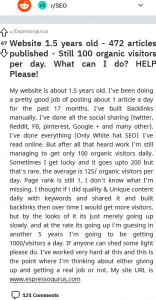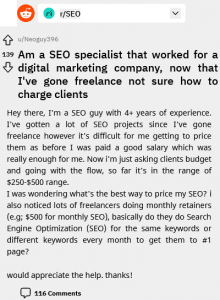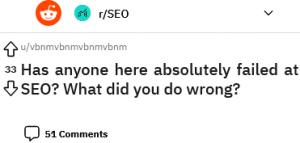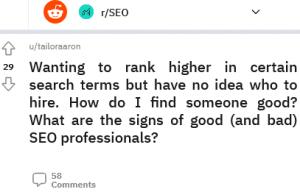Discussion 2: SaaS SEO Case study: 1 Mil to 6.4 Million Monthly Organic Traffic
Noel
1 Mil to 6.4 Million Monthly Organic Traffic – SaaS SEO Case study
Hey guys! So as the title says, I and Nick recently hit 6.4 monthly organic traffic per month for a Software as a Service (SaaS) website in the HR space.
To "celebrate", we published a mega-list of 40 SEO tips and practices that helped us get there.
We published the original post on Reddit but thought you guys would dig it too. The URL is in the comments, but here's a quick preview 😉
We're also creating a more step-by-step case study next week, so will post that once it's up. Stay tuned.
TIP #1. SOURCE A TON OF WRITERS🖊️
Content writing is one of those professions that has a very low barrier to entry. Anyone can take a writing course, claim to be a writer, and create an UpWork account…
This is why 99% of the writers you'll have to apply for your gigs are going to be, well, horrible.
As such, if you want to produce a lot of content on the reg, you'll need to source a LOT of writers.
Let's do the math:
If by posting a job ad, you source 100 writers, you'll see that only 5 of them are a good fit. Out of the 5 writers, 1 has a very high rate, so they drop out. Another doesn't reply back to your communication, which leaves you with 3 writers.
You get the 3 writers to do a trial task, and only one turns out to be a good fit for your team.
Now, since the writer is freelance, the best they can do is 4 articles per month for a total of 5,000-words (which, for most niches, ain't all that much).
So, what we're getting at here is, to hire quality writers, you should source a LOT of them.
TIP #2. FOCUS ON ONE NICHE AT A TIME🌐
We used to work with this one client that had a SaaS consisting of a mixture of Client Relationship Management (CRM), Accounting Software, and HRS.
We had to pick whether we were going to focus on topics for one of these 3 niches or focus on all of them at the same time.
We decided to do the former. Here's why:
When evaluating what to rank, Google considers the authority of your website.
If you have 60 articles about accounting (most of which link to each other), you're probably an authority in the niche and are more likely to get good rankings.
If you have 20 sales, 20 HR, and 20 accounting articles, though, none of these categories are going to rank as well.
It always makes more sense to first focus on a single niche (the one that generates the best Return of Investment (RoI) for your business), and then move on to the rest.
This also makes it easier to hire writers – you hire writers specialized in accounting, instead of having to find writers who can pull off 3 unrelated topics.
TIP #3. TEST & IMPROVE SEO HEADLINES🧪
Sometimes, you'll see that you're ranking in the top 3 positions for your search query, but you're still not driving that much traffic.
"What's the deal?" you might be asking.
Chances are, your headline is not clickable enough.
Every 3-4 months, go through your Google Search Console and check for articles that are ranking well but not driving enough traffic.
Then, create a Google sheet and include the following data:
Targeted keyword
Page link
Click Through Rate (CTR) (for the last 28 days)
Date when you implemented the new title
Old title
New title
New CTR (for the month after the CTR change was implemented)
From then on, implement the new headline and track changes in the CTR. If you don't reach your desired result, you can always test another headline.
TIP #4. MAKE YOUR CONTENT VISUAL🎨
How good your content looks matters, especially if you're in a competitive niche.
Here are some tips on how to make your content as visual as possible:
Aim for 2-4 sentences per paragraph. Avoid huge blocks of text.
Apply a 60-65% content width to your blog pages.
Pick a good-looking font. I'd recommend Montserrat, PT Sans, and Roboto. Alternatively, you can also check out your favorite blogs, see which fonts they're using, and do the same.
Use a reasonable font size. Most top blogs use font sizes ranging from 16 pt to 22 pt.
Add images when possible. Avoid stock photos, though. No one wants to see random "office people smiling" scattered around your blog posts.
Use content boxes to help convey information better.
TIP #5. STOP IGNORING THE OUTREACH EMAILS YOU'RE GETTING (AND USE THEM TO BUILD YOUR OWN LINKS)
Got a ton of people emailing you asking for links?
You might be tempted to just send them all straight to spam, and I don't blame you.
Outreach messages like "Hey Noel, your article is A+++ amazing! …can I get a backlink?" can get hella annoying.
That said, there IS a better way to deal with these emails:
Reply and ask for a link back. Most of the time, people who send such outreach emails are also doing heavy guest posting. So, you can ask for a backlink from a 3rd-party website in exchange for you mentioning their link in your article.
Win-win!
Full Reddit Post URL (w/ all 40 tips) down in the comments!
289 👍🏽45 💟340
143 💬🗨
📰👈
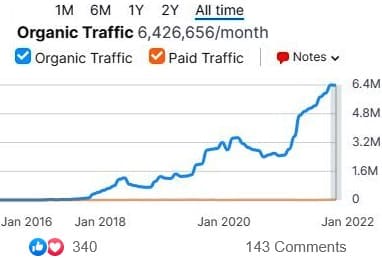
Great! Things I would like to know: 1. How much did the client spend in that allotted time period?
2. How much did this increase in traffic affect their revenue?
Thank you! And great work!
I would rather not disclose the exact amounts. I can tell you that they've gotten more than 20x direct Return of Investment (RoI) from the money they spent on Search Engine Optimization (SEO) with us. I'm confident that number will probably be higher in a year's time since we have not raised our rates and the results get exponentially better.
They've been with us for 3 years. It took us 1.5 years to reach 2mil organic.
Joe Youngblood 🎓
Update: Just in case anyone is curious or wants to report this post. Noel has graciously and privately provided our mod team with evidence we were able to use to prove that the above case study is indeed authentic.
Great SEO work Noel! Thanks again for sharing with our group and helping others.
Thanks for resolving this matter man
Kote
Great direction. "TIP #2. FOCUS ON ONE NICHE AT A TIME " — makes total sense not just in this context but with business or with everything.
1. Which FB groups are your favorite for finding the writers?
2. What's your experience with DMCA Notice?
– And what do you consider as a copy (exact word by word)?
Noel ✍️ » Kote
No specific group tbh. It's better to find freelancing/digital nomad groups for specific cities/countries and hire from there. Chances are, if you post on a freelance writers group, you'll get 500 spam messages from unqualified writers.
Referrals has been the best. Especially recent graduates from universities.
ProBlogger is not bad either for sourcing a ton of writers. And some subreddits for hiring people, like r/forhire are also good.
Kote » Noel
Thx. make sense.
Basheer
Nice thanks but can you please tell us how many backlinks you created and how much did they cost you?
We didn't pay for any backlinks.
Most of them are organic, the rest are done through tedious outreach. No guest posting, nothing fishy, just a ton of work.
Basheer » Noel
Great, thanks for the answer.
Frost
Excellent advice. On your backlink point, are you basically saying to people who outreach to you that you will link to them if they link to you from another site they control?
Pretty much yes. Or you can ask them to link to one of your client's sites and you can link to them from your own site. Anything that's A-B-C essentially, and that has topical relevance.
For example, I wouldn't link to a casino affiliate website, from our site, and then ask them to link to our client's HR site. That'd be detrimental.
Frost » Noel
Yep I see what you mean, similar to what I've been trying … does work quite well 😃
📰👈
An Agency Said 7 Niches Contains Most Clients: Dental, Eye Care, Hospitals, SaaS, Education, Finance, and Cannabis!
SEO Is Easy! The Exact Process We Use to Scale Our Client own SEO From 0 to 200K Monthly Traffic and Beyond
Discussion 1: 15 Lessons from My First $15 Million Total Revenue
15 lessons from our first $15 million in recurring revenue Hey Reddit,
I wrote this post for my blog, but thought you might all find it interesting. Happy to answer any questions!
Last week we crossed $15 million in annual recurring revenue (ARR) for ConvertKit, my email marketing company. My original dream was to get to $600,000 in ARR, so I'm pretty thrilled! Over the last six years I've learned and written about quite a few lessons, but it's always fun to reminisce on the highlights, that oddly enough mostly come from the hardest times.
1. Focus is everything
It's fine to start something on the side, but if you want to turn it something real it needs to move to the center of your focus. Years ago I decided to go all in on ConvertKit https://convertkit.com/doubling-down-on-convertkit/, moving it from a side project to my only project.
Without that decision ConvertKit wouldn't be here today.
Anytime someone brags about how many businesses they run I cringe. I'd far rather take one thing and do it really well. I'll leave the serial entrepreneurship for the scattered, the wannabes, or those who are truly far more talented than I am.
A friend told me the other day that he was surprised I still only did ConvertKit. At this point we have an incredible team, available capital, and the leverage of an audience. Why not start something else and run it in parallel?
Because I know myself.
Focus is where I thrive. Focus is where I get results. Focus is everything.
2. Choose a niche
Choosing a niche is the easiest advice to give and the hardest advice to take. When you don't have traction, it feels like choosing a niche will exclude the few people who are coming in the door. In reality when we chose "email marketing for professional bloggers" everything changed.
Messaging became clear, the product roadmap was trimmed, and the prospect lists practically wrote itself.
Without that change-without excluding everyone who didn't fit into the blogger bucket-it would have been incredibly hard to get off the ground.
We eventually expanded to "email marketing for creators," which now includes podcasters, actors, YouTubers, authors, artists, musicians, and so many more. Even with growing into that larger audience we are still so much more focused than our competitors who target all small-businesses.
3. Use sales to kickstart word-of-mouth
Word-of-mouth is the best way to grow a company, but you need traction for the referrals to start. That's where direct sales come in. By choosing a niche, listing out your prospects, and getting in touch directly you no longer have to wait for them to come to you.
Each conversation-even though most end in rejection-will teach you so much. At first it's one customer. Then five. Then ten.
Immediately you'll notice something crucial: the customers you recruit are higher quality than the ones who just walk in the door. Why would you leave the future of your product up to just anyone who stumbles across what you create?
Instead go out and sell to the customers you want. Then ask them for referrals. Finally, when the word-of-mouth referrals kick in, they will be to the right people.
4. Do the hard work that doesn't scale
Each sales call would end the same way: "I love what you're doing and I'd love to switch…but it's too much work. Sorry."
Ouch. No matter how much convincing I did I wasn't able to overcome that objection. That is until I offered to do the full switch for them for free.
That meant getting their account access, moving every form, copying and pasting every sequence email, exporting and importing their subscribers, and so much more! It was terribly unprofitable to do that for a $79/month customer. But early on that was how we got momentum. Every customer matters.
So many people told me that wasn't scalable. I needed to use paid ads, Search Engine Optimization (SEO), or some other scalable way to acquire customers. That's great if you can make them work, but many can't. So I did the work that no one else was willing to do.
John and Patrick Collison famously did this with Stripe. Rather than waiting to follow-up after a promising conversation, they would migrate other startups to Stripe on the spot.
Don't wait for the follow-up or have the customer do all the work. Do the hard work that doesn't scale.
Today we still offer a free concierge migration for anyone over 5,000 email subscribers. Many of our competitors have copied it and offer it as well.
It feels good to make them react to us.
5. Find what works and repeat it
Webinars were the first scalable growth channel we found that really worked. My first thought was to do those and keep searching for the next thing…but then I realized that we should focus on what's working. We test and iterate like crazy, but then once it pays off we go all in.
Over the last three years we've done hundreds of webinars with an incredible number of affiliate partners. They are hard, time consuming, and exhausting. But they work.
Run all the experiments. Test. Analyze the data. The when you find something that works be prepared to go all in.
6. Building infrastructure to support growth will take far longer than estimated
We spent our first company retreat fighting fires and rebuilding our server infrastructure. What was supposed to be a time to just connect, plan, and get to know each other turned into an all hands on deck fight to keep our product online.
I thought we'd spend nearly all our time building cool new features for customers. But instead the work was in doing what customers care about most: making sure the basics work well. Emails need to send on time and subscriptions need to work flawlessly.
There's a lot of software that when it goes down, you just work on something else. Not email marketing. It's core to the entire business and reliability is everything.
The infrastructure that was built to support 1,000 customers will break at 10,000. It's crucial to dedicate time to support the growth.
7. Funding is optional
Right about now we should be raising a $25 million series A. Or at least that's what our peers are doing. Instead we haven't raised a single dime of outside capital. I put in $5,000 to kick things off, then another $50,000 when I doubled down on ConvertKit.
Getting rejected by venture capitalists is one of the best things that's ever happened to me.
We built ConvertKit our way, at our pace, and with our values. Every line of code is funded by the creators we serve. I wouldn't have it any other way.
8. It's possible with a smaller team than most people think
Today at ConvertKit we have 38 amazing team members. At $15 million ARR that is nearly $400,000 per team member! A much higher ratio than any of our peers. At this stage 75 employees would be normal.
Instead of hiring as quickly as possible to solve every pain, we are deliberate about working on the right things. The constraint requires us to say no, not spread ourselves thin, and only do the highest leverage work.
It also means that we can invest in each team member more and carefully craft the culture we want, rather than simply focus on reaching headcount goals.
There are always tradeoffs, maybe we could move faster, build more, or support customers better. So we are still striving to find the right balance between team size, efficiency, and total output.
9. Culture is everything-and it's not what you think
We have so many weird habits as a team at ConvertKit: talking about someone in the third person as if they're not there, long walks in pairs where only one person is allowed to talk, starting meetings by asking, "red, yellow, or green?" and diving directly into the hard conversations.
That's because to us culture isn't bean bag chairs and free lunch, but instead an environment where conflict is kind and direct, expectations are clear, and trust is most important.
Our version of culture has turned ConvertKit into a place that we all want to come to work.
10. Share the profits
There are two important factors for running ConvertKit as a financially efficient company:
• Transparent financials. Every dollar spent is visible to the entire company through our open books.
• Profit sharing. We share more than 50% of the profit in the company with the entire team.
The result is that everyone is incentivized to spend money efficiently.
We once asked the team: "would you rather go to San Diego or Costa Rica for the next team retreat?"
Everyone said Costa Rica.
So we did the research and found that Costa Rica would cost about 50% more because of higher housing costs and additional travel logistics. With the complete picture we asked the team again.
This time San Diego won by a landslide.
That attitude carries over to everyone when they use their company credit card. It's not just the company's money, it's their money. And they spend it accordingly.
In the last few years we've distributed over $1,000,000 to the team in profit sharing. All while spending aggressively on growth. That's a number I'm really proud of!
11. Always pay your debts
No, I'm not talking about Game of Thrones, or even financial debt. There's another kind of debt more devastating to software companies: technical debt.
The code that worked fine at $15,000 in revenue looks like a joke at $15 million. Not to say you should have spent the time to build it perfectly from the beginning-that's a fools game to try-but instead that every shortcut you take is building more debt. The longer you wait the more interest accrues.
We've had to spend a significant of time and money refactoring all of that old code. It's part of scaling. Every software company has to do it, but it would be so frustrating if we didn't expect it and have a plan to pay it back systematically.
12. As you grow, your company's name builds equity. Don't take that for granted.
For years I've wanted to build ConvertKit into a global brand and I thought that meant changing the name to something more brandable. While being focused on this new change I completely missed the trust, care, and love our customers had for the name ConvertKit.
You just quietly enjoy the status quo. People only talk about what they want to change. It would be weird to send an email to Patagonia saying, "I really love your name, please don't change it."
So when we would receive emails every month from creators who thought ConvertKit was too salesy and they didn't want to be associated with the brand, that wasn't balanced by all the people who had quietly grown to love our name and the brand it represented.
Ultimately we decided to stay as ConvertKit, which is a long story that I promise I'll write in full at some point.
13. You don't have to be an asshole to build a successful company
Being an asshole is one way some entrepreneurs have been able to build big companies. Assholes are often loud about their own success, so we hear about them more than we should. But there are a bunch of good people building exciting companies too. Good people who care for their team, their family, and their customers.
Ignore the entrepreneur media.
Don't be an asshole and don't settle for working for one.
14. Surprise launches aren't worth it
A surprise launch or release is fun for you… until it isn't.
I love having my Steve Jobs moment by unveiling a new feature to the applause of a crowd. I've done it the last two years at our conference, Craft + Commerce https://conference.convertkit.com/. But behind each of those moments is weeks or months of pushing hard to make a deadline. Trimming the project scope, reprioritizing backlogs, and hoping that everything goes well in the live demo.
But that's only part of it. What follows is releasing to customers, which is really painful if you missed the mark on any of your designs, planning, or timelines. That means a ton of tickets in the support queue, frustrated users, and losing confidence in the product.
Now we've moved away from launching these big surprises. Instead we work with smaller groups of customers to understand how a new product or change will affect them. Then we use that information to build a smarter launch and rollout plan. A plan that usually involves methodically rolling out to a few features at once.
We're still be able to make a splash, but we are able to do it with more confidence and a lot less stress.
15. I felt most successful after the hardest decisions
While skiing a few weeks ago my friend Anthony https://www.breakthetwitch.com/ asked the group, "do you feel successful?" It was a great question to reflect on while riding the chairlift. I'm always striving to learn more and grow the company, so it's foreign to pause and feel success. That feels like settling when I know I'm capable of more.
Overall, I do feel successful, but I was surprised to realize the moments I felt most successful weren't after hitting a major revenue milestone or landing a famous customer.
In hindsight, the times I felt most successful were when I leaned on my principles to make the right decision, even though it was incredibly hard.
Letting a senior leader go. Rolling back a name change I'd worked on for two years. Restructuring the company.
I wrestled with each one. Struggling to have the courage to make the decision I knew was right. But with principles to guide me I could make the decision with confidence.
To me success knows that I've built the courage to make the right decision, especially when it is painful and expensive.
Dozens of Checklists for The Marketing Team Who Has Got No SEOers
AMA Case Study: Amazon Affiliate Website From $267 to $21,853 per Month in 19 Months


